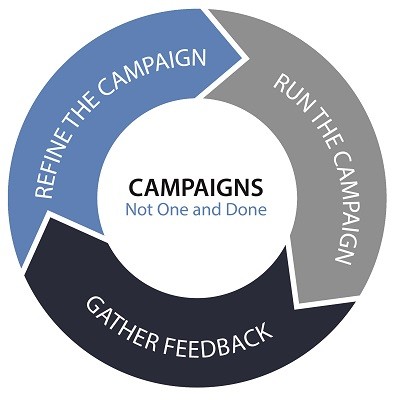JoomConnect Blog
Campaigns: Not One and Done
There is a misconception that after developing a campaign, your work is finished. People have the belief that once completed they will have the ability to run the campaign continuously, and continue to get leads. Campaigns are essentially a process of tasks that are carried out with the intent on improving the awareness of goods or services. Just like any process, the campaign will need to be refined, and repaired before being used again. The following is a quick look at the cycle that every campaign, regardless of type or size, should go through:
Begin and Run the Campaign
Once pieces have been created, and all of the content has been written it is time to begin sending the campaign to your chosen marketing group. (Make sure your group is composed of well vetted contacts, or money will be lost). You will want to make sure that goals and metrics are clearly set, as they will be important after the campaign has been completed.
Review the Success of the Campaign
After the campaign has completed, you should measure its success by reviewing your goals and metrics. You should prepare to follow up and move any suspects/prospects further down the marketing funnel toward a sale. Some feedback from your campaign will be explicitly laid out in the metrics set up prior to the start of the campaign. For more in depth feedback, you should consider a survey. With a survey you can ask more specific questions about your recipient's perception of the campaign. You can use this information to refine the campaign for use in the future.
Refine the Campaign
Now that you’ve identified the strong, and weaker pieces of your campaign, it can be refined. Changes made should encourage better results the next time it is used. There are three major parts to refinement:
- Feedback based - All of the responses you got from your audience should be considered in this step. At this time information will be added or removed, content value will be increased, and consideration of any other insights provided by your audience should also take place.
- Internal observations - At this step, the processes of the campaign with data will be refined. (Your audience would not typically notice these). A few examples of internal observations include:
- Did you select the best resources for execution?
- Did you have trouble tracking the campaign with the metrics you’d originally chosen?
- Does printing of marketing collateral require more time for execution?
- Was the venue for your event ideal?
- List updates/additions - After each campaign, you should compare the contacts on your marketing list with the potential ROI. Depending on the results, removing contacts from your marketing group may be necessary. If contacts have been added to your groups, it's important to make sure campaign lists are updated. Your company’s marketing lists should be constantly evolving.
Run Again
After improvements are made, the next step is beginning and running the campaign again. This run should achieve better results than the previous.
Your marketing strategy must be adaptable. Without an adaptable strategy your competition will easily outwit and outperform you. There are always improvements and edits that can be made. Your should make it your goal to give your target audience valuable information that can help improve their business, and in turn you will get the same. If you need assistance with the planning or execution of a marketing campaign, the marketing team at JoomConnect is readily available to create and execute a killer campaign, sure to deliver results. Contact us today!




Comments